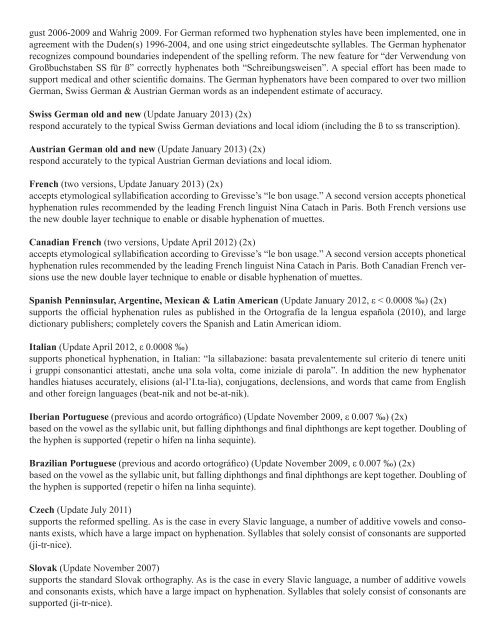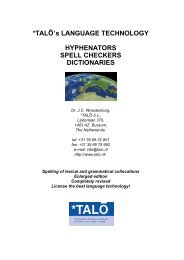Hyphenators — language specifications - Talo
Hyphenators — language specifications - Talo
Hyphenators — language specifications - Talo
You also want an ePaper? Increase the reach of your titles
YUMPU automatically turns print PDFs into web optimized ePapers that Google loves.
gust 2006-2009 and Wahrig 2009. For German reformed two hyphenation styles have been implemented, one in<br />
agreement with the Duden(s) 1996-2004, and one using strict eingedeutschte syllables. The German hyphenator<br />
recognizes compound boundaries independent of the spelling reform. The new feature for “der Verwendung von<br />
Großbuchstaben SS für ß” correctly hyphenates both “Schreibungsweisen”. A special effort has been made to<br />
support medical and other scientific domains. The German hyphenators have been compared to over two million<br />
German, Swiss German & Austrian German words as an independent estimate of accuracy.<br />
Swiss German old and new (Update January 2013) (2x)<br />
respond accurately to the typical Swiss German deviations and local idiom (including the ß to ss transcription).<br />
Austrian German old and new (Update January 2013) (2x)<br />
respond accurately to the typical Austrian German deviations and local idiom.<br />
French (two versions, Update January 2013) (2x)<br />
accepts etymological syllabification according to Grevisse’s “le bon usage.” A second version accepts phonetical<br />
hyphenation rules recommended by the leading French linguist Nina Catach in Paris. Both French versions use<br />
the new double layer technique to enable or disable hyphenation of muettes.<br />
Canadian French (two versions, Update April 2012) (2x)<br />
accepts etymological syllabification according to Grevisse’s “le bon usage.” A second version accepts phonetical<br />
hyphenation rules recommended by the leading French linguist Nina Catach in Paris. Both Canadian French versions<br />
use the new double layer technique to enable or disable hyphenation of muettes.<br />
Spanish Penninsular, Argentine, Mexican & Latin American (Update January 2012, ε < 0.0008 ‰) (2x)<br />
supports the official hyphenation rules as published in the Ortografía de la lengua española (2010), and large<br />
dictionary publishers; completely covers the Spanish and Latin American idiom.<br />
Italian (Update April 2012, ε 0.0008 ‰)<br />
supports phonetical hyphenation, in Italian: “la sillabazione: basata prevalentemente sul criterio di tenere uniti<br />
i gruppi consonantici attestati, anche una sola volta, come iniziale di parola”. In addition the new hyphenator<br />
handles hiatuses accurately, elisions (al-l’I.ta-lia), conjugations, declensions, and words that came from English<br />
and other foreign <strong>language</strong>s (beat-nik and not be-at-nik).<br />
Iberian Portuguese (previous and acordo ortográfico) (Update November 2009, ε 0.007 ‰) (2x)<br />
based on the vowel as the syllabic unit, but falling diphthongs and final diphthongs are kept together. Doubling of<br />
the hyphen is supported (repetir o hífen na linha sequinte).<br />
Brazilian Portuguese (previous and acordo ortográfico) (Update November 2009, ε 0.007 ‰) (2x)<br />
based on the vowel as the syllabic unit, but falling diphthongs and final diphthongs are kept together. Doubling of<br />
the hyphen is supported (repetir o hífen na linha sequinte).<br />
Czech (Update July 2011)<br />
supports the reformed spelling. As is the case in every Slavic <strong>language</strong>, a number of additive vowels and consonants<br />
exists, which have a large impact on hyphenation. Syllables that solely consist of consonants are supported<br />
(ji-tr-nice).<br />
Slovak (Update November 2007)<br />
supports the standard Slovak orthography. As is the case in every Slavic <strong>language</strong>, a number of additive vowels<br />
and consonants exists, which have a large impact on hyphenation. Syllables that solely consist of consonants are<br />
supported (ji-tr-nice).




